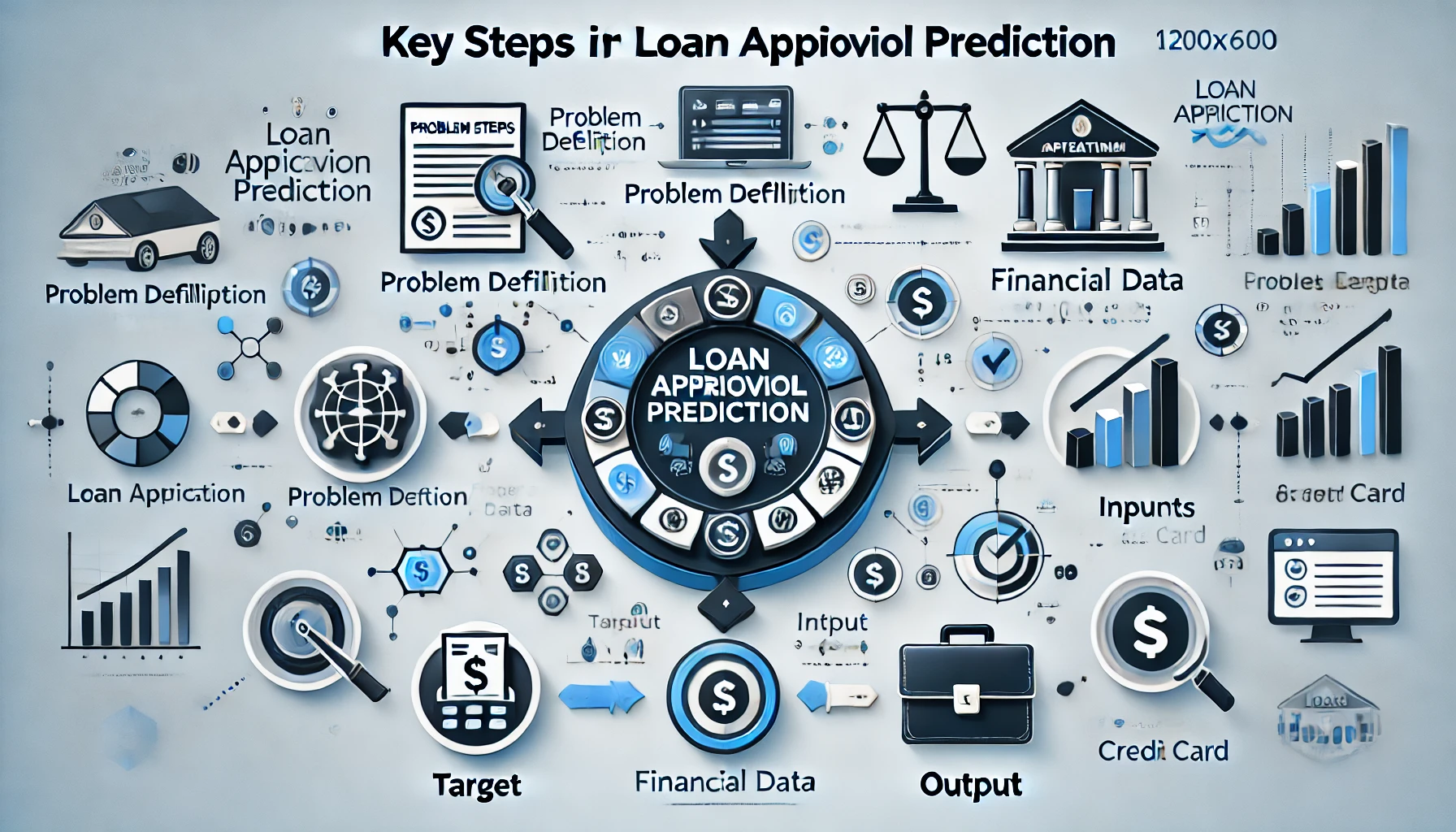ML has disrupted several industries by facilitating better and more efficient decisions. One common use is Loan Approval Prediction Using ML, a significant matter for banks and financial institutions.ML algorithms can help institutions process massive datasets, identify patterns, and improve accuracy. This article aims to introduce you to the idea of predicting loan approval with the use of machine learning, its advantages, applications, as well as the method to construct robust models to minimize risks.
Why Use Machine Learning for Loan Approval?
Historically, manual review of financial records, credit scores, and subjective risk assessments drove loan approval decisions. But this traditional approach has some serious drawbacks:
- Time-consuming: Manual reviews often require days or weeks to finalize decisions, delaying loan processing.
- Prone to bias: Human subjectivity can lead to unfair or inconsistent evaluations, potentially excluding deserving applicants.
- Error-prone: Errors in manual calculations or oversight can result in inaccurate risk assessments, increasing defaults.

Machine learning effectively addresses these challenges by:
- Also finding: Big Data in Insurance and Financial Services and machine learning models, programmed with data until October 2023.
- Improving Accuracy: Advanced algorithms analyze diverse datasets to deliver precise and reliable risk predictions, reducing default rates.
- Enhancing Scalability: Machine learning systems can handle a growing number of applications without performance degradation, supporting institutions as they expand their operations.
- Providing Insights: ML models often reveal hidden patterns and trends in data, offering valuable insights that help refine lending strategies and manage risks more effectively.

Key Steps in Loan Approval Prediction
Here are the major steps involved in building a loan approval prediction system using machine learning:
1. Problem Definition
Before starting with machine learning, it is important to understand the problem statement for following a systematic approach towards solving a problem.
- Target: Ultimately, the goal is to analyze whether or not to approve a loan application, so that banks and other financial institutions can make faster and more at ease decisions.
- The output — given the input data, the model will output a binary classification of whether the application would be “Approved” or “Rejected”.
- Inputs: Relevant information about the applicant will be used as input features, such as:
- Income: The applicant’s earnings, providing insight into repayment capability.
- Employment status: Stability and type of employment as indicators of financial reliability.
- Credit history: A record of past borrowing behavior, crucial for assessing risk.
- Loan amount: The requested loan size relative to the applicant’s financial profile.

2. Data Collection
Gathering relevant data is essential for training the ML model. Common data sources include:
- Financial Records: Bank statements, tax returns.
- Credit Reports: Your credit scores and repayment history.
- Demographics: Age, education, and marital status.
Example Dataset:
| Feature | Description |
|---|---|
| Applicant Income | Monthly income of the applicant |
| Loan Amount | Total loan amount requested |
| Credit Score | Numerical creditworthiness score |
|
Job Status |
Employment status (such as Full-time, Part-time) |
| Loan Approval Status | Approved/Rejected |
3. Data Preprocessing
In most cases you have to clean and prepare the data before the data is ready for use in a machine learning model. Key preprocessing steps include:
- Handling Missing Values: Replace or remove missing entries.
- Encoding Categorical Data: Convert categories (e.g., “Yes,” “No”) into numerical values.
- Scaling Numerical Data: Normalize features like income and loan amounts for consistency.
Preprocessing Example:
| Raw Data | After Preprocessing |
| Applicant Income: 0 | Applicant Income: Mean Value |
| Credit Score: “Good” | Credit Score: 700 |
4. Feature Selection
Basically, to build an effective machine learning model some very important key points to consider is about identifying as well as selecting the most relevant features. It also enhances model performance, lowers computational costs, and prevents overfitting. Examples of important features for loan approval prediction include:
- Borrower Income: Primary factor to assess the ability of the borrower to pay back the loan.
- Loan Amount: The sum of the loan that is being applied for the evaluation of the applicant’s ability to pay relative to their income.
- Credit History — Past record of an applicant with regard to his credit behavior, giving a picture of its individual performance and risk.
- Now, we move on to the Loan Tenure: The period over which the loan is to be repaid.
![]()
Other potential features to consider include:
- Dti = Debt-to-Income Ratio: Measure of Financial Stability Based on Income And Existing Debt Obligations
- Type of Employment: Part-time, full-time, or self employed (job security indications).
- Age and Dependents Useful for contextualizing financial responsibilities and repayment potential
5. Splitting the Dataset
Now, the dataset must be partitioned distinctively to ensure that the model is trained well and tested properly. This is useful for evaluating the model’s ability to generalize on unseen data.
- Training Set:
-
Encompasses most of the data, around 70-80% of the full dataset.
- Data until 2023 October
-
- Testing Set:
-
Consists of the rest 20–30 % of the data
- Used to test the model on unseen data and calculate its metrics like accuracy, precision, recall, and F1-score.
-
![]()
Additional Considerations:
- Stratification: When splitting the dataset, if the target is imbalanced (for example if you have if you have many more approved loans than rejected loans), you should split stratified, so the same proportions of classes (target variable) appear in both subset.
- Validation Set: Optionally, reserve a separate validation set (e.g., 10-15%) for hyperparameter tuning and model selection, keeping the testing set untouched until final performance evaluation.
- Random: Shuffle [randomly permute] the data before splitting.
6. Choosing the Right Machine Learning Algorithm
Several ML algorithms can be used for loan approval prediction. Here’s a comparison:
| Algorithm | Pros | Cons |
| Logistic Regression | Simple and interpretable | May struggle with complex patterns |
| Decision Trees | Handles non-linear data well | Prone to overfitting |
| Random Forest | Robust and accurate | Computationally intensive |
| Support Vector Machine | Works well with smaller datasets | Difficult to interpret |
| Neural Networks | Handles large and complex datasets | Requires significant computational resources |
7. Model Training
You will train a machine learning algorithm to recognize patterns in the provided training data so that it can make accurate predictions on previously unseen data. Key considerations include:
- Data Preparation: Preprocess the data before training including normalizing numerical features, encoding categorical and handling missing values to maintain data consistency and reliability.
- Cross-Validation: Split the dataset multiple times using k-fold cross-validation to create training and validation sets. This builds model generalization assessment as well as prevents
- Hyperparameter Tuning: You can improve the model performance by some trial and error with different hyperparameters using a grid search or random search. I.e., according to the algorithm, specify learning rates, tree depths, iterations, etc.

8. Model Evaluation
Evaluate the trained model using metrics such as:
- Accuracy: Percentage of correct predictions.
- Precision: True positive rate for approved loans.
- Recall: Ability to identify all approved loans.
- F1 Score: Balance between precision and recall.
Example Metrics Comparison:
| Metric | Model 1 (Logistic Regression) | Model 2 (Random Forest) |
| Accuracy | 85% | 92% |
| Precision | 80% | 90% |
| Recall | 78% | 88% |
| F1 Score | 79% | 89% |
FAQs
1. Can machine learning guarantee accurate loan approvals?
Machine learning can vastly improve accuracy, but there is no such thing as a 100 percent safe system. Regular updates and monitoring are essential.
2. Is machine learning expensive to implement?
Initial implementation can be costly, but it saves time and money in the long run by automating decisions and reducing errors.
3.How about if the model is wrong in its prediction?
Loan officers should always review borderline cases. Machine learning models are designed to assist, not replace human decision-making entirely.
4.What data is most crucial?
Three most decisive features for loan approval are credit history, income, employment status.
5. Can small banks use this technology?
Yes, there are many open-source tools and cloud services that bring machine learning within reach of smaller organizations.
Conclusion
Machine Learning in Loan prediction approval is revolutionizing the Finance world with speedier, accurate, and less biased processes. This simple approach to the right data, algorithms and evaluation metric can help financial institutions to achieve efficiencies and improved customer experience. As the technology advances so should its access and efficiency which would make it a useful asset for businesses of all sizes. Thus, the development of interpretable models capable of explaining such decisions to stakeholders helps increase transparency in the field and prevent regulatory snake oil.


